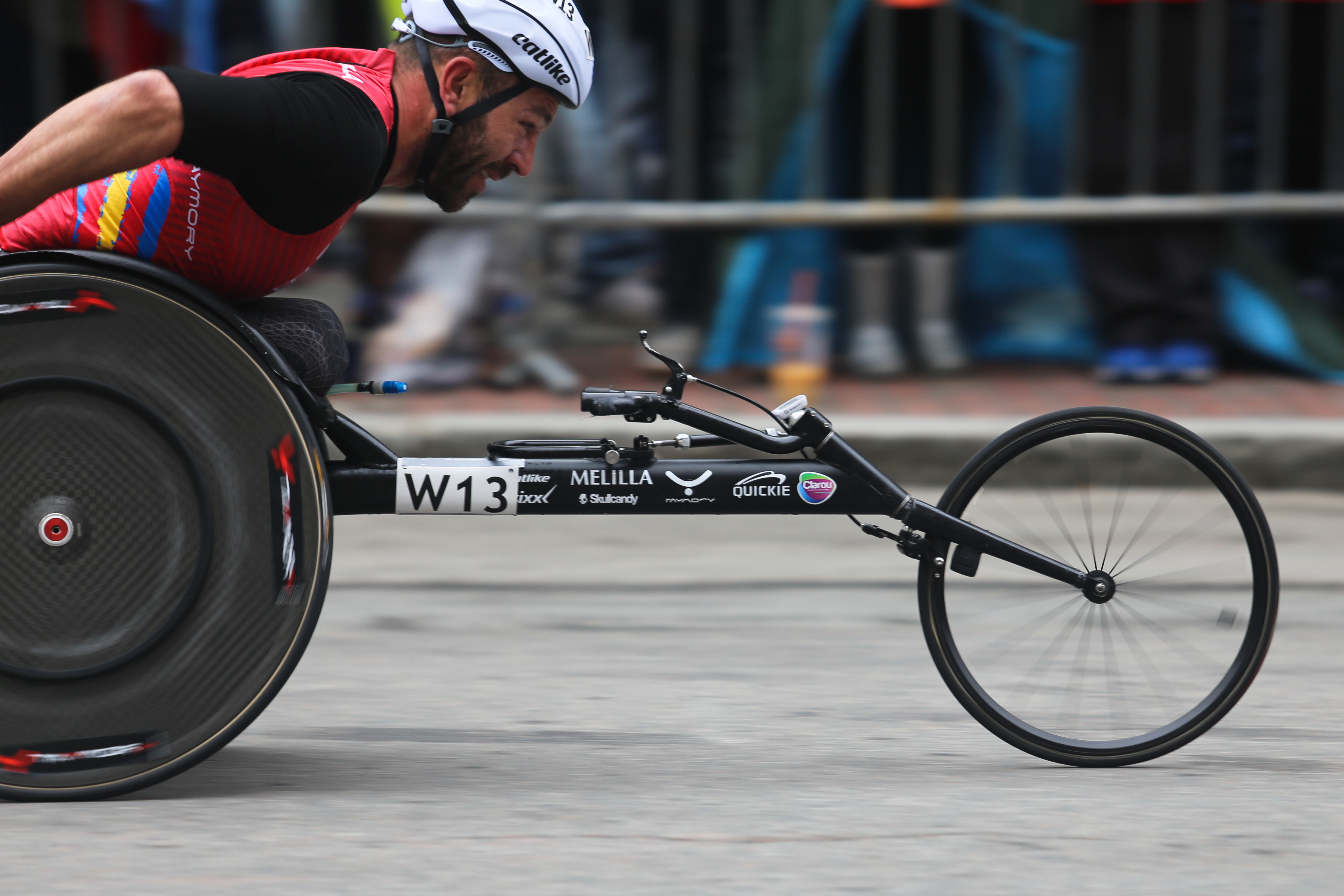By Ryan Cross, Sarah Faulkerner, Michaela Kane
BU News Service
On April 18, more than 30,000 runners will line up at the start line of the Boston Marathon, ready to race 26.2 miles and cross the finish line in Copley Square. For many runners, this is a lifetime achievement, the result of months or even years of training. But recent studies suggest that running isn’t necessarily all it’s cracked up to be.
Racing the Wave of Running Injuries
According to the National Center for Biotechnology Information, between 37 and 56 percent of runners are injured every year. Runners face stress injuries in their thighs, calves, knees, feet and ankles, caused by the repetitive movements required for running. This wave of injuries isn’t necessarily surprising, since running is technically a high-impact sport, requiring its participants to smack their feet on the pavement mile after mile, day after day. Each stride forward creates a jolt of force that shoots up from the sole of the foot to their ankles, knees and hips. And after a while, that repetitive jolt can be a problem.
Today, a majority of running injuries occur in the knee. The most common injury, called Patellofemoral Pain Syndrome (PFPS), more commonly referred to as Runner’s Knee, accounts for 42 percent of all knee injuries from running. This happens when irritation occurs between the kneecap and the thighbone, sometimes damaging the cartilage in the knee. Other common injuries include plantar fasciitis, which causes pain and inflammation in the heel; shin splints, which involve pain in the lower part of the leg, usually centered in the shins; inflammation of the Achilles Tendon and even sprains or fractures in the ankles, shins and knees.
While injury rates in runners may be on the rise, studies have shown that these rates don’t indicate that every runner who laces up their sneakers will get injured. Many studies show that novice runners are more than twice as likely to get injured when compared to experienced runners who have practiced the correct running forms and training regiments. Additionally, runners who train with an injury or have a history of weakness or pain in their legs and joints are also more likely to injure themselves again when out pounding the pavement.
Although the rate of running injuries climbed over the last 30 years, it has not deterred people from running. In fact, according to Running USA, which publishes a State of the Sport report every year, the number of people participating in marathons across the U.S. has steadily climbed between 1990 and 2015, only dropping in 2012 after the New York Marathon was canceled, taking 50,000 racers out of the count.
For Healthy Hearts, Moderation is Key
A 2012 study examined 10 years of marathon running in search of an extreme: runners who die either during or immediately after a marathon. Its conclusion had runners everywhere breathing a sigh of relief.
Researchers found that between 2000 and 2009, there was no change in the average performance of a marathon runner – it still takes an average marathon runner about four and a half hours to finish. They also discovered that the death rate over that period of time remained unchanged. In other words, the increase in runners was not associated with more deaths.
Of the 3.7 million surveyed participants, the researchers identified 28 people who died. The majority of the deaths were due to a heart related problem — cardiac arrest, a heart attack being the most common.
The study concluded that there hasn’t been a change in average performance or death rate in marathon running, despite a boom in the number of runners. But perhaps the factoid that comforted runners the most is that the odds of suffering a heart-related death while running a marathon is extremely small.
Not surprisingly, there is too much of a good thing. A separate study looked at the prevalence of heart troubles in veteran endurance athletes — people who run marathons and ultramarathons ( more than 50 miles) frequently. They found that half of the surveyed veteran male endurance athletes had myocardial fibrosis, despite being healthy and asymptomatic. Myocardial fibrosis is the thickening of the heart valves, a sign of progression towards heart failure.
The prevalence of myocardial fibrosis was not due to age, height or weight. Instead, it was strongly associated with the number of years training and the number of years spent running competitive marathons and ultra-endurance marathons. While causation is certainly not clear, some researchers suggest studies like this point to a potential limit in human endurance.
Whatever the case may be, it seems the average marathon runner can embrace the challenge of their race without fear of a heart attack.
The Marathoner’s Metabolism
In addition to cardiovascular fitness, many people may view the metabolism boost that comes with regular running as a primary benefit. While it is difficult to quantify the exact number of calories a run will burn, many modern health and fitness apps, as well as the old-fashioned treadmill, estimate 100 calories per mile of running. For rudimentary measurements, this number works, but there are many variables that change that oft-cited statistic. Body weight, age, sex, speed, distance, and environmental conditions such as the temperature and rain will all alter energy demands during a run.
One noteworthy benefit of long runs is elevated lipolysis, or fat metabolism. A study of 25 Boston Marathon runners showed that lipolysis increased by 1128 percent following the race. When the body runs out of glucose (sugar), the preferred energy source, it will begin metabolizing fats called triglycerides. The breakdown of triglycerides releases free fatty acids and a glycerol molecule. It was the measurement of increased glycerol molecules in the bloodstream that allowed the researchers to quantify the change in fat metabolism.
Burning off some extra calories during a run seems like a good thing, but there could be a downside. Serious distance runners, like most athletes, need to consume a large number of extra calories to fuel their runs. This continually increased calorie consumption in serious may take a toll on the body.
Health studies in animals show that the most reliable way to increase longevity is to drastically reduce calorie count. This doesn’t necessarily imply that eating more contributes to a shorter lifespan in humans, but there is a line of thought developing among metabolism researchers that reduced food intake may be the easiest and best way to improve long-term health. Although necessary for their runs, the large amount of calories runners need to consume may have long-term consequences for their metabolism.
While it is difficult to connect running to specific metabolic benefits or disadvantages, one researcher determined some correlations with marathon running and lower medication usage for hypertension, cholesterol, and diabetes.
A more immediately measurable harm of marathon running comes from measuring ion levels for sodium, magnesium, and potassium in the blood, which may contribute to collapse, where a marathoner is unable to finish the race. In extreme cases, drastically altered ion levels can result in death.
One study showed that nearly a third of collapsed runners had dysnatremia, which is abnormally high or low sodium levels. Hypernatremia, where the sodium is too high, was found in 27.7% of the runners, and may be caused by insufficient water intake. Hyponatremia, where the sodium is too low, was found in 4.8% of runners, and can surprisingly be caused by drinking too much water. Another study in collapsed runners found that 49% had decreased calcium levels and 19.5% had reduced magnesium levels.
It takes considerable training and effort to prepare your body to tackle this feat. Experienced distance runners have a much lower rate of injury than novice runners, who now, more than ever, are lining up to race in these marathons. Statistically, it’s unlikely there will be any serious damage to your heart and metabolism, but you have a greater risk of damaging damaged joints and sore legs if this is your first marathon.










